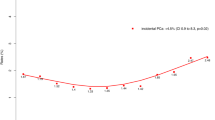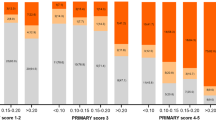Abstract
Introduction and Objectives: Dwight D. Eisenhower Army Medical Center has been involved in Prostate Cancer Awareness Week (PCAW) screening during the period 1995–2000. The purpose of this study is to review the results of screening in a self-selected population of military beneficiaries at our institution.
Materials and Methods: Screening involving a brief urologic history, digital rectal examination (DRE) and serum prostatic specific antigen (PSA) measurement was offered to our screening population. Patients with an elevated PSA (>4.0 ng/ml) and/or a suspicious DRE were considered for transrectal ultrasonography with prostate needle biopsy (TRUS/PNB). Patient health records were reviewed retrospectively and analyzed to determine patient demographic characteristics, PSA distribution, DRE results and cancer detection rates.
Results: A total of 455 screening visits were performed from 1995 to 2000, of which 426 visits were included for analysis. Mean age of the study population was 57.4 y (40–83). Seventy-one percent of the patients reported prior PSA screening visits. Forty-four patients met indications for biopsy. A total of 30 TRUS/PNB were performed demonstrating presence of cancer in three patients for an overall cancer detection rate of 0.7%.
Conclusions: Our study shows that the overall prostate cancer detection rate at our institution is lower than detection rates previously reported in the literature. Potential reasons for this finding may include that the subjects participating in PCAW screening tended to be younger than in other series and that a majority of them had already undergone prior screening. These findings suggest the need to modify prostate cancer screening recommendations and to improve prostate cancer screening efficacy.
This is a preview of subscription content, access via your institution
Access options
Subscribe to this journal
Receive 4 print issues and online access
$259.00 per year
only $64.75 per issue
Buy this article
- Purchase on Springer Link
- Instant access to full article PDF
Prices may be subject to local taxes which are calculated during checkout
Similar content being viewed by others
References
Greenlee RT, Murray T, Bolden S, Wingo P. . Cancer statistics, 2000. Cancer J Clin 2000 50: 7–33.
Keetch DW, Andriole GL. . Prostate cancer screening: what are physicians to do? What have we learned? Monographs in Urology 1996 17: 31–48.
Presti JC, Schröeder FH, Albert PS, Lynch J. . Early diagnosis and staging of prostate cancer. 10th International Prostate Cancer Update. Rev Urol 2000 2: 19–22.
Etzioni R et al. Cancer surveillance series: interpreting trends in prostate cancer--part III: quantifying the link between population prostate-specific antigen testing and recent declines in prostate cancer mortality. J Natl Cancer Inst 1999 91: 1033–1039.
Schröder FH, Bangma CH. . The European randomized study of screening for prostate cancer. Br J Urol 1997 79: Suppl 1 68–71.
Babaian RJ et al. The relationship of prostate specific antigen to digital rectal examination and transrectal ultrasonography. Cancer 1992 69: 1195–1200.
Bretton PR. . Prostate specific antigen and digital rectal examination in screening for prostate cancer. Southern Med J 1994 87: 720–723.
Catalona WJ et al. Comparison of digital rectal examination and serum prostate specific antigen in the early detection of prostate cancer. J Urol 1994 151: 1283–1290.
Rietbergen JB et al. The changing pattern of prostate cancer at the time of diagnosis. J Urol 1999 161: 1192–1198.
Brawer MK et al. Screening for prostatic carcinoma with prostate specific antigen. J Urol 1992 147: 841–845.
Eskew LA, Bare RL, McCullough DL. . Systematic 5 region prostate biopsy is superior to sextant method for diagnosing carcinoma of the prostate. J Urol 1997 157: 199–202.
Oesterling JE et al. Serum prostate specific antigen in a community-based population of healthy men. Establishment of age-specific reference ranges. JAMA 1993 270: 860–865.
Meigs JB et al. High rates of prostate specific antigen testing in men with evidence of benign prostatic hyperplasia. Am J Med 1998 104: 517–525.
Carter HB et al. Recommended prostate specific antigen testing intervals for the detection of curable prostate cancer. JAMA 1997 277: 1456–1460.
Gann PH. . Interpreting recent trends in prostate cancer incidence and mortality. Epidemiology 1997 8: 117–120.
Thompson IM, Optenberg SA. . An overview cost-utility analysis of prostate cancer screening. Oncology (Huntingt) 1995 9: Suppl 11 141–145.
Pearson JD et al. When is PSA testing no longer necessary? J Urol 1998 159: 178.
Author information
Authors and Affiliations
Corresponding author
Rights and permissions
About this article
Cite this article
Soderdahl, D., Hernandez, J. Prostate cancer screening at an equal access tertiary care center: its impact 10 years after the introduction of PSA. Prostate Cancer Prostatic Dis 5, 32–35 (2002). https://doi.org/10.1038/sj.pcan.4500555
Received:
Revised:
Accepted:
Published:
Issue Date:
DOI: https://doi.org/10.1038/sj.pcan.4500555



